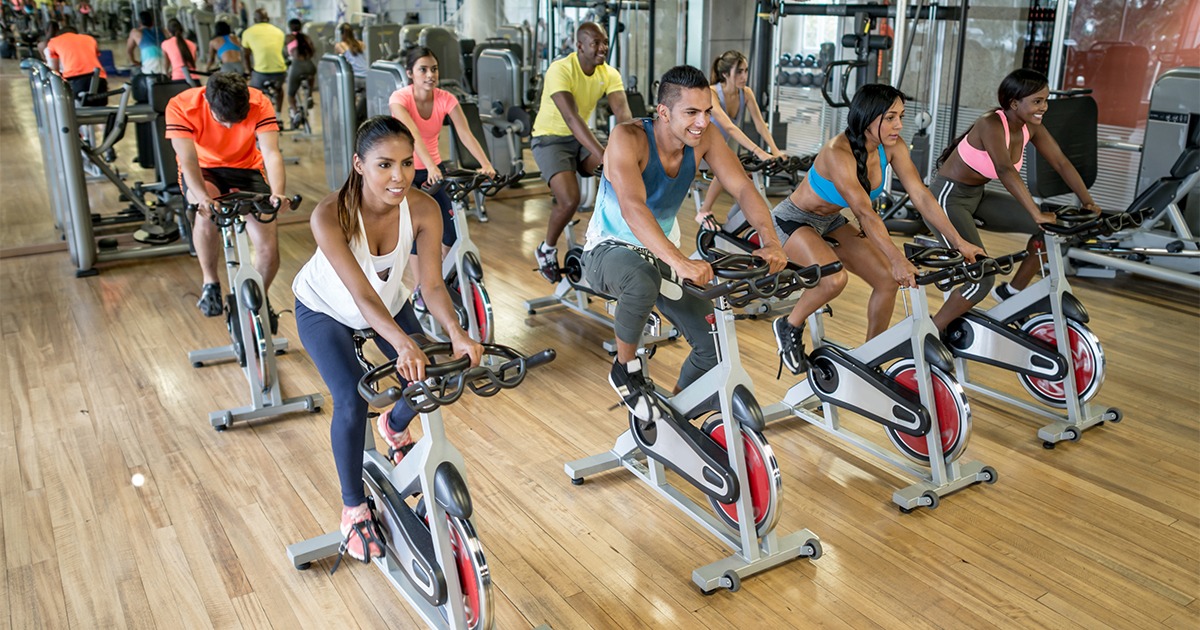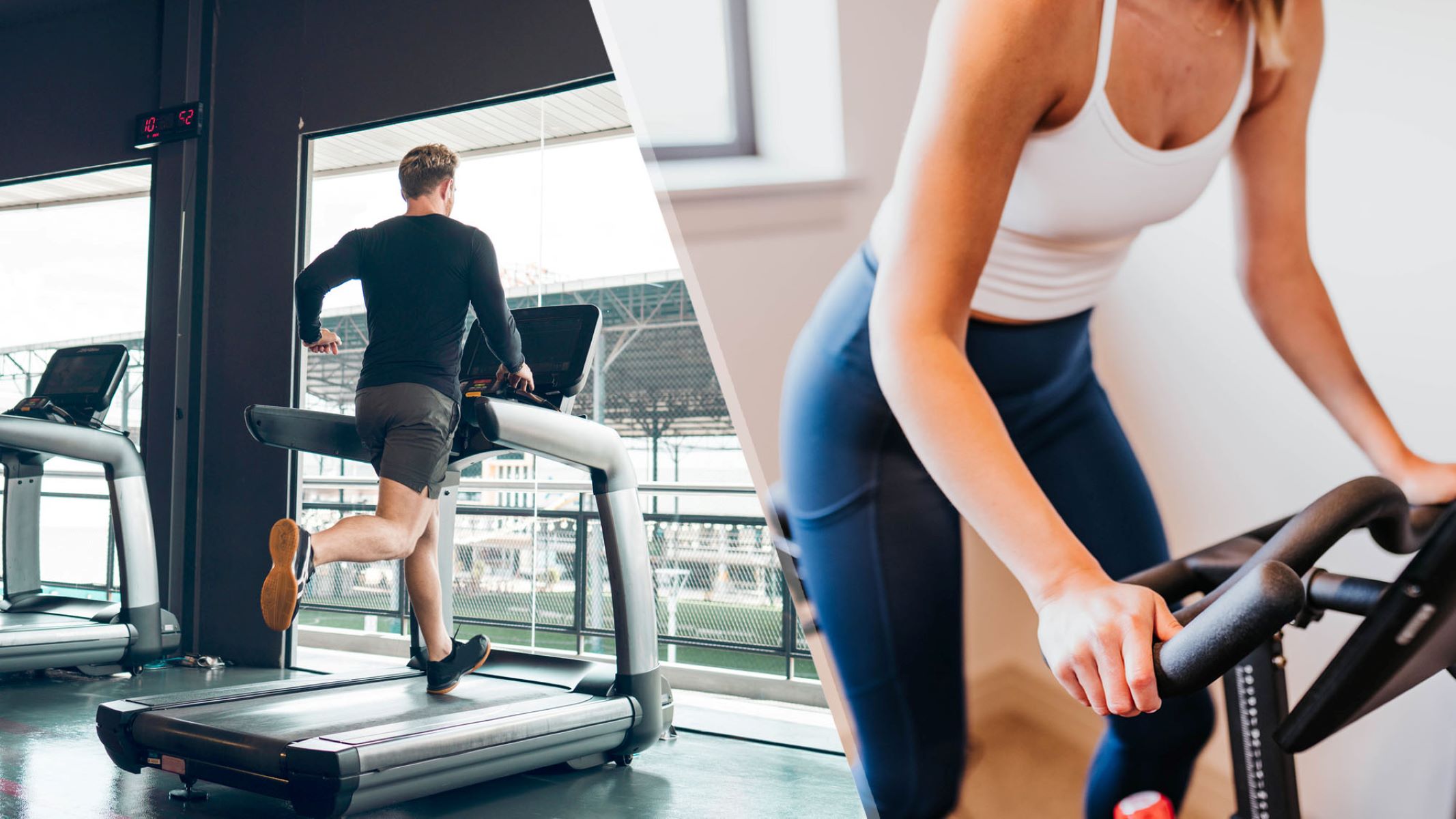

Featured
What Is Spinning Exercise
Published: September 30, 2023
Discover the benefits of featured spinning exercise and how it can improve your fitness level. Uncover the secrets of this popular indoor cycling workout and start spinning your way to a healthier you.
Introduction
Welcome to the world of spinning exercise! If you’re looking for a fun and intense way to get your heart pumping and burn some serious calories, spinning might just be the perfect fit for you. Whether you’re a seasoned cyclist or a beginner looking to improve your fitness level, spinning exercise offers a high-energy workout that can be tailored to suit your individual needs.
Spinning exercise, also known as indoor cycling, has gained tremendous popularity in recent years. It involves riding on a stationary bike, typically in a group setting with an experienced instructor leading the workout. The class is designed to simulate various terrains and intensities, giving you a dynamic and engaging cardio workout that targets your lower body muscles and improves cardiovascular endurance.
But spinning is not just about pedaling furiously on a stationary bike. It’s a full-body workout that engages multiple muscle groups, including your core, arms, and back. By incorporating different resistance levels and speed intervals, it challenges your cardiovascular system and boosts your metabolism, helping you achieve your weight loss and fitness goals.
Besides the physical benefits, spinning exercise also provides mental and emotional advantages. Engaging in a spinning class can be a great stress reliever, as you can fully immerse yourself in the high-energy music and supportive atmosphere. It’s also a fantastic way to connect with like-minded individuals, build a sense of community, and stay motivated on your fitness journey.
In this article, we’ll explore the benefits of spinning exercise, how it works, the equipment you’ll need, proper form and technique, tips for a successful workout, and safety considerations to keep in mind. Whether you’re a beginner or an experienced spinner, this comprehensive guide will provide you with the information you need to make the most out of your spinning experience.
Benefits of Spinning Exercise
Spinning exercise offers numerous benefits for both your physical and mental well-being. Let’s take a closer look at some of the key advantages:
- Cardiovascular Health: Spinning is an excellent aerobic exercise that gets your heart pumping and increases your overall cardiovascular endurance. Regular spinning workouts can help lower your blood pressure, improve circulation, and reduce the risk of heart disease.
- Weight Loss: If shedding pounds is one of your goals, spinning can be an effective tool in your weight loss journey. A single spinning session can burn a significant number of calories, making it an ideal choice for those wanting to lose weight and increase their overall calorie burn.
- Low-Impact Workout: The beauty of spinning is that it provides a low-impact workout that puts minimal stress on your joints. This makes it an excellent option for individuals with joint pain or injuries, allowing them to engage in a challenging cardiovascular workout without risking further damage to their body.
- Leg Strength and Muscle Tone: Spinning primarily targets the muscles in your legs, including your quadriceps, hamstrings, glutes, and calves. Regular spinning sessions can help strengthen and tone these muscles, giving you leaner and more defined legs.
- Core Stability: While spinning mainly focuses on the lower body, it also engages your core muscles, including your abdominals and lower back. Maintaining proper form during a spinning workout requires a stable core, which can lead to improved posture and a stronger midsection.
- Mental Well-being: Spinning is not just a physical workout; it can also have a positive impact on your mental health. The high-energy music, supportive environment, and sense of accomplishment can boost your mood, reduce stress levels, and increase overall feelings of happiness and well-being.
These benefits highlight why spinning exercise has become such a popular option for fitness enthusiasts of all levels. Whether you’re looking to improve your cardiovascular health, lose weight, tone your muscles, or simply enjoy a challenging and invigorating workout, spinning can be a valuable addition to your fitness routine.
How Spinning Exercise Works
Spinning exercise is structured to mimic the experience of outdoor cycling, but in an indoor environment. It is designed to provide a challenging and dynamic workout that engages both your cardiovascular system and your lower body muscles. Here’s how spinning exercise works:
1. Resistance and Intensity Levels: The intensity of your spinning workout can be adjusted by modifying the resistance on the stationary bike. By turning a knob or pressing buttons, you can increase or decrease the resistance, simulating different terrains such as flat roads, uphill climbs, or sprint intervals.
2. Cadence and RPM: Cadence refers to the speed at which you pedal. In spinning, RPM (revolutions per minute) is used as a measure of cadence. The instructor will guide you to maintain a specific RPM range throughout the workout, ensuring that you maintain a steady and controlled pace to optimize your cardiovascular endurance.
3. Interval Training: Spinning workouts often incorporate interval training, which involves alternating between periods of high-intensity effort and active recovery. This type of training is effective for improving cardiovascular fitness and burning calories. It keeps your heart rate elevated and challenges your body in different ways.
4. Visualization: Spinning classes often include visualization techniques to enhance the immersive experience. The instructor may guide you to imagine cycling through beautiful landscapes or challenging outdoor scenarios, helping to keep your mind focused, engaged, and motivated throughout the workout.
5. Music: Music plays a crucial role in spinning exercise, creating a high-energy and motivating atmosphere. Instructors carefully select music tracks that complement the pace and intensity of the workout, ensuring that you stay motivated and energized throughout the class.
By incorporating these elements into your spinning exercise routine, you’ll be able to challenge yourself physically and mentally while enjoying a dynamic and engaging workout. Whether you’re a beginner or an experienced spinner, the versatility and customization of spinning make it suitable for individuals of all fitness levels.
Equipment Needed for Spinning Exercise
To get started with spinning exercise, you’ll need a few key pieces of equipment. Here’s a breakdown of what you’ll need:
- Indoor Cycling Bike: The most crucial piece of equipment for spinning exercise is an indoor cycling bike. These specialized stationary bikes are designed specifically for spinning workouts, with features such as adjustable resistance, comfortable seats, and handlebars that simulate outdoor cycling positions. You can find indoor cycling bikes at your local gym or invest in one for your home.
- Appropriate Clothing: While there isn’t a specific dress code for spinning exercise, it’s important to wear comfortable workout clothing that allows for freedom of movement. Opt for moisture-wicking fabrics that help keep you cool and dry. Many spinners prefer padded cycling shorts for extra comfort during longer rides.
- Comfortable Athletic Shoes: It’s crucial to wear appropriate athletic shoes that provide support and stability during your spinning workouts. Look for shoes with a rigid sole and good traction. Indoor cycling-specific shoes with cleats that can be attached to the pedals are also an option for more advanced spinners.
- Towel and Water Bottle: Spinning exercise can be intense and make you work up a sweat, so it’s essential to have a towel to wipe off perspiration and a water bottle to stay hydrated throughout the workout. Most spinning studios provide towel service, but bringing your own can offer added convenience.
- Heart Rate Monitor (Optional): While not necessary, using a heart rate monitor can help you track your exertion levels and ensure you’re working within your target heart rate zone. It can be a useful tool for monitoring your progress and maintaining appropriate intensity during your spinning workouts.
When it comes to equipment for spinning exercise, it’s essential to prioritize safety and comfort. Investing in a good-quality indoor cycling bike and wearing appropriate clothing and shoes will enhance your spinning experience and help you get the most out of your workouts.
Proper Form and Technique
Proper form and technique are crucial in spinning exercise to ensure an effective and safe workout. Here are some key guidelines to follow:
- Body Alignment: Maintain proper posture throughout the workout. Align your head, neck, and spine, keeping your shoulders relaxed and down. Engage your core muscles to support your back and maintain stability.
- Hand Position: Place your hands gently on the handlebars, avoiding gripping too tightly. Keep your wrists in a neutral position and avoid putting excessive pressure on the handlebars.
- Pedaling Technique: Pedal with a smooth and fluid motion, avoiding sudden jerks or pushing too hard. Aim for a consistent and controlled cadence, following the instructor’s guidance or maintaining a comfortable pace within your target RPM range.
- Resistance Adjustment: Adjust the resistance on the bike according to the instructor’s cues or your own comfort level. Start with a lower resistance and gradually increase it as you become more confident and stronger in your spinning workouts.
- Breathing: Breathe rhythmically and deeply throughout the workout. Inhale through your nose and exhale through your mouth, allowing for optimal oxygen uptake and carbon dioxide release.
- Saddle Position: Adjust the saddle height to ensure proper leg extension. When pedaling, your knees should be slightly bent at the bottom of the pedal stroke, and your hips should remain stable without excessive rocking.
- Variety in Movements: Follow your instructor’s cues to vary your bike movements. This may include standing up, sitting down, sprinting, or performing speed intervals. Listen to your body and choose modifications if needed to avoid strain or injury.
Remember, everyone’s fitness level and flexibility may differ, so finding your ideal positioning and comfort is important. If you are unsure about your form or technique, don’t hesitate to ask your instructor for guidance or attend a beginner’s class to learn the basics.
By practicing proper form and technique in your spinning exercise, you’ll not only maximize the benefits of the workout but also reduce the chance of injury and discomfort. Focus on developing a smooth and efficient pedal stroke and maintaining a strong and stable core throughout your spinning sessions.
Tips for a Successful Spinning Workout
To make the most out of your spinning exercise and have a successful workout, consider the following tips:
- Arrive Early: Arrive at the spinning class a few minutes early to set up your bike properly and get familiar with the studio layout. This will help you start the session on time and avoid any last-minute stress.
- Hydrate Before and During: Drink plenty of water before your spinning workout to stay hydrated. Remember to bring a water bottle and sip on it during the workout to replenish fluids lost through sweat.
- Listen to Your Body: Pay attention to how your body feels during the workout. If you feel any sharp pain or discomfort, make adjustments as necessary or take a break. Push yourself, but also know your limits to prevent injury.
- Follow the Instructor: Stay in sync with the instructor’s cues and guidance. They will guide you through different resistance levels, speed drills, and movements. Trust their expertise and follow their instructions for an effective workout.
- Focus on Breathing: Practice deliberate and controlled breathing during your spinning workout. Focus on deep inhales and exhales, matching your breath to your pedal strokes. This can help regulate your heart rate and keep you focused and calm.
- Challenge Yourself: Push yourself outside your comfort zone during your spinning workouts. Gradually increase the resistance, try to maintain a higher cadence, or accept the instructor’s challenge for a sprint interval. Pushing your limits will help you achieve new levels of fitness and strength.
- Have Fun: Remember to enjoy yourself! Spinning exercise can be intense, but it’s also an opportunity to have fun and enjoy the music and supportive atmosphere. Embrace the energy of the class and use it to motivate and inspire you throughout your workout.
These tips will help you have a successful and enjoyable spinning workout. Remember that consistency is key, so aim to incorporate spinning into your fitness routine regularly to see the best results. And don’t forget to celebrate your accomplishments along the way!
Safety Considerations
While spinning exercise is generally safe for most individuals, it’s essential to prioritize safety during your workouts. Here are some safety considerations to keep in mind:
- Consult with a healthcare professional: If you have any underlying health conditions or are new to exercise, it’s recommended to consult with a healthcare professional before starting a spinning exercise program. They can provide personalized advice and ensure that spinning is suitable for you.
- Proper Bike Setup: Ensure that your bike is set up correctly to prevent discomfort or injury. Adjust the saddle height, handlebar position, and pedal straps to ensure proper alignment and support. If you’re unsure about bike setup, ask your instructor for assistance.
- Warm Up and Cool Down: Always begin your spinning workout with a proper warm-up to prepare your body for the intensity. Perform gentle stretches and start with a lower resistance. Similarly, end your workout with a cooldown period to gradually bring your heart rate down and stretch your muscles.
- Listen to Your Body: Pay attention to any signs of pain, dizziness, or excessive fatigue during your spinning workouts. If you experience any discomfort, modify or reduce the intensity of the exercise. It’s important to respect your body’s limits and avoid overexertion.
- Proper Hydration: Drink water before, during, and after your spinning workouts to stay hydrated. Dehydration can lead to dizziness, fatigue, and muscle cramps. Ensure that your water bottle is easily accessible during the workout.
- Appropriate Clothing and Footwear: Wear appropriate workout clothing that allows for freedom of movement and supports your body during the workout. Choose comfortable athletic shoes that provide stability and cushioning for your feet.
- Gradual Progression: Start with shorter spinning sessions and gradually increase the duration and intensity of your workouts. Push yourself, but avoid sudden and drastic increases in resistance or speed, as this can increase the risk of injury.
- Follow Safety Guidelines: Pay attention to any safety guidelines or rules provided by the spinning studio or instructor. Familiarize yourself with emergency procedures and know how to stop the bike quickly if needed.
- Use Proper Form: Maintain proper form and technique throughout your spinning workout to prevent strain and injury. Focus on your alignment, pedal stroke, and posture, keeping your core engaged and your movements controlled.
Remember, your safety should always be the top priority during any exercise program. By following these safety considerations, you can reduce the risk of injury and have a safe and enjoyable spinning experience.
Conclusion
Spinning exercise is a fantastic way to improve cardiovascular fitness, burn calories, and strengthen your lower body muscles. With its high-energy music, dynamic workouts, and supportive community, spinning offers a fun and engaging alternative to traditional cardio exercises.
In this article, we explored the benefits of spinning exercise, including improvements in cardiovascular health, weight loss, and muscle tone. We discussed how spinning works and the equipment needed to get started. Additionally, we provided tips for maintaining proper form and technique, ensuring a safe and effective workout. Lastly, we highlighted the importance of safety considerations to minimize the risk of injury during your spinning sessions.
Spinning exercise is suitable for individuals of all fitness levels. Beginners can start at a lower intensity and gradually build up their strength and stamina, while more advanced spinners can challenge themselves with higher resistance and faster cadences. With the guidance of a skilled instructor, you can customize your workout to meet your specific goals and preferences.
So, if you’re looking for a challenging and exhilarating workout that will boost your endurance, tone your muscles, and leave you feeling energized, give spinning exercise a try. Strap on those cycling shoes, hop on the bike, and get ready to pedal your way to a fitter and healthier you.
Remember, always listen to your body, stay hydrated, and have fun. Let the music and the collective energy of the class motivate you to push past your limits and achieve your fitness goals. Whether you’re a spinning beginner or a seasoned pro, spinning exercise offers an opportunity to challenge yourself, improve your fitness, and enjoy a sense of accomplishment. Get ready to spin your way to a healthier and happier lifestyle!









